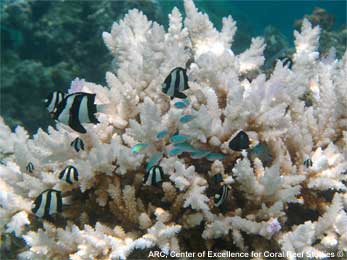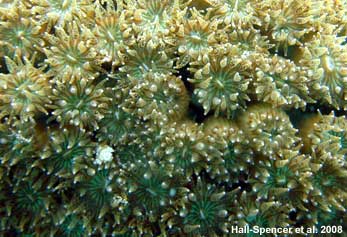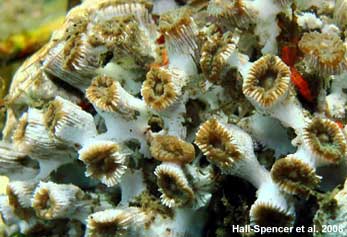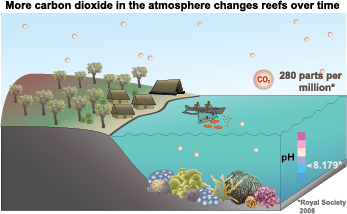How does climate change affect coral reefs? |
The warmer air and ocean surface temperatures brought on by climate change impact corals and alter coral reef communities by prompting coral bleaching events and altering ocean chemistry. These impacts affect corals and the many organisms that use coral reefs as habitat.
Climate change leads to coral bleaching
Warmer water temperatures brought on by climate change stress corals because they are very sensitive to changes in temperature. If water temperatures stay higher than usual for many weeks, the zooxanthellae they depend on for some of their food leave their tissue. Without zooxanthellae, corals turn white because zooxanthellae give corals their color. White, unhealthy corals are called bleached. Bleached corals are weak and less able to combat disease.
Bleaching events on coral reefs around the globe were observed in 1998 (West and Salm 2003). In some Pacific islands, a little bit of bleaching is common in the summer; however, there have been times when bleaching is particularly bad in this region (Craig 2009). For example, larger than normal bleaching events in the National Park of American Samoa occurred in 1994, 2002, and 2003 (Craig 2009). As climate change continues, bleaching will become more common, and the overall health of coral reefs will decline.
Climate change alters ocean chemistry leading to ocean acidification
Much of the carbon dioxide that enters the atmosphere dissolves into the ocean. In fact, the oceans have absorbed about 1/3 of the carbon dioxide produced from human activities since 1800 and about 1/2 of the carbon dioxide produced by burning fossil fuels (Sabine et al. 2004). As carbon dioxide in the ocean increases, ocean pH decreases or becomes more acidic. This is called ocean acidification.
With ocean acidification, corals cannot absorb the calcium carbonate they need to maintain their skeletons and the stony skeletons that support corals and reefs will dissolve. Already, ocean acidification has lowered the pH of the ocean by about 0.11 units (SCOR 2009). Moving the ocean's pH from 8.179 to a current pH of 8.069, which means the ocean is about 30% more acidic now than it was in 1751 (SCOR 2009). If nothing is done to reduce carbon dioxide emissions into the atmosphere, ocean acidification will increase and more and more corals will be damaged or destroyed.


Ocean acidification affects more than just corals. Snails, clams, and urchins also make calcium carbonate shells and ocean acidification negatively impacts these organisms as well. Just like corals, ocean acidification makes it harder for these organisms to absorb the calcium carbonate they need to build their shells.


 If we continue to produce carbon dioxide at the current rate, future atmospheric carbon dioxide will be high enough to lower ocean surface pH to 7.8 by the year 2100 (Royal Society 2008). Scientists have done laboratory studies that suggest a pH about this low could dissolve coral skeletons and may cause reefs to fall apart (Fine and Tchernov 2006). If coral reefs are lost, vital habitat will be lost too. The future health of coral reefs and many marine organisms depends on our ability to reduce our carbon dioxide emissions on a global scale.
If we continue to produce carbon dioxide at the current rate, future atmospheric carbon dioxide will be high enough to lower ocean surface pH to 7.8 by the year 2100 (Royal Society 2008). Scientists have done laboratory studies that suggest a pH about this low could dissolve coral skeletons and may cause reefs to fall apart (Fine and Tchernov 2006). If coral reefs are lost, vital habitat will be lost too. The future health of coral reefs and many marine organisms depends on our ability to reduce our carbon dioxide emissions on a global scale.
Future emissions depend on how many people there are on the planet, what energy sources we use, how much energy we use, what new technologies we create—just to name a few factors. So, how do scientists investigate what the world will look like in the future if it is not know what future greenhouse gas emissions will be?
They try to make predictions about what the world will look like in the future by using different scenarios. For example, scientists from all over the world work together on the Intergovernmental Panel on Climate Change (IPCC) to generate models that reflect different rates of population growth, economic growth, technology application, and social change. These models help us understand what climate change means for our future and have predicted how the ocean pH may decrease as carbon dioxide emissions increase.
Of course, climate change affects more than just coral reefs and has implications for national parks outside of the Pacific Island Network. Explore how other parks are anticipate the impacts of climate change on their ecosystems.
| Ê»Ino ka moana ke ahu mÅkÄkÄ« nei ka puna i uka. The sea is rough, for the corals are strewn on the beach. (Here are all the indications that there is trouble yonder.) | This Hawaiian proverb reminds us the sky and ocean are connected, with the conditions of the atmosphere influencing those of the ocean. |





